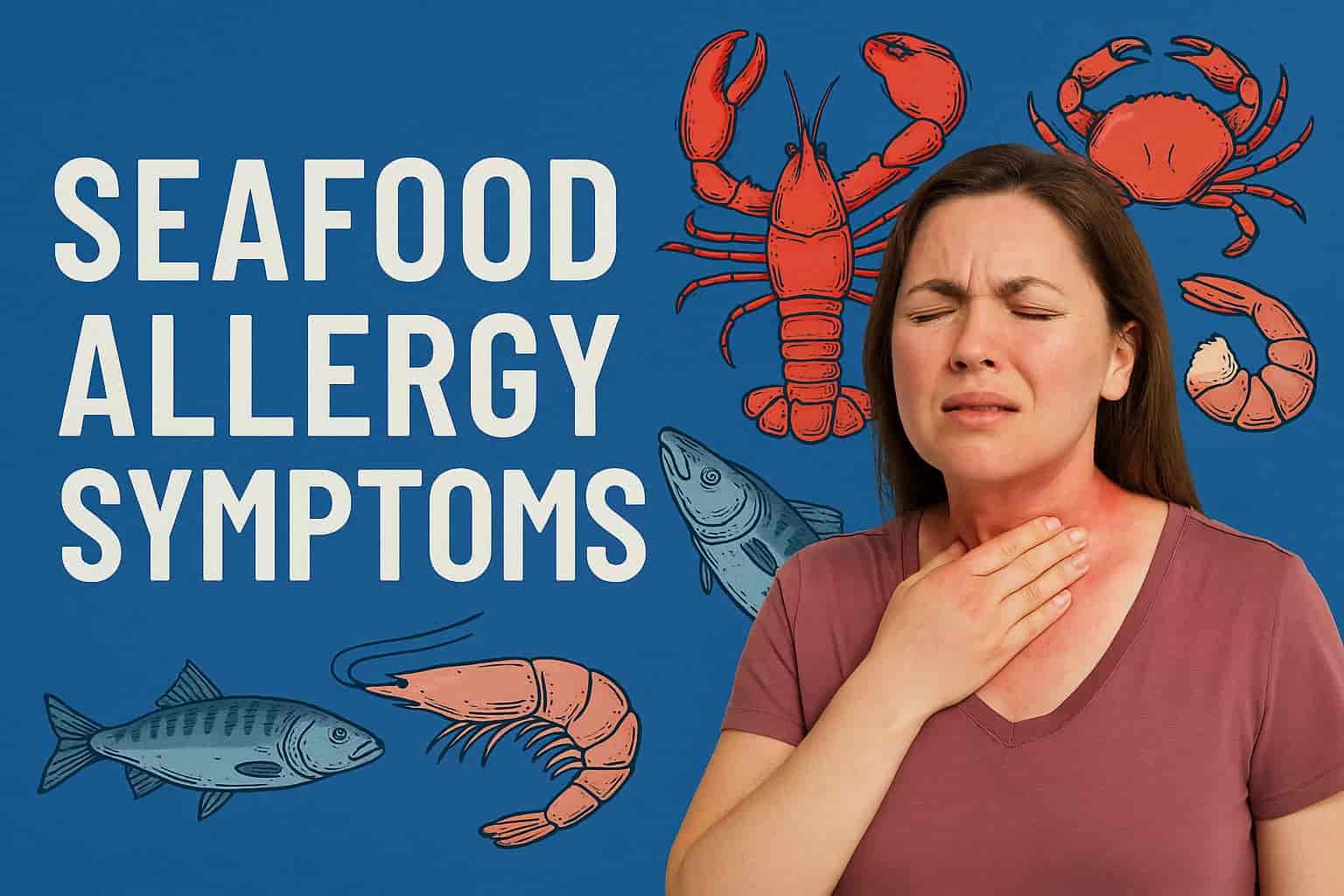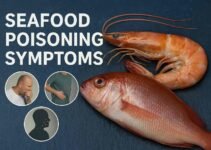Seafood allergies are a significant health concern, affecting an estimated 2.3% of adults and 1.3% of children globally. These allergies often develop unexpectedly and can lead to severe, life-threatening reactions. Recognizing the early symptoms is critical to prevent complications and ensure immediate treatment. Unlike other food allergies, seafood allergies typically persist throughout life and rarely resolve over time.
This guide provides clear, factual answers to the most frequently asked questions about seafood allergy symptoms. You will learn how to identify early warning signs, differentiate between mild and severe reactions, and take appropriate actions if symptoms occur. Whether you’re managing a known allergy or suspect a new sensitivity, this resource will help you stay informed and safe.
Contents
- 1 What Are the Most Common Early Symptoms of a Seafood Allergy?
- 2 How Quickly Do Seafood Allergy Symptoms Appear After Consumption?
- 3 What Are the Severe Symptoms of a Seafood Allergy That Require Emergency Care?
- 4 Which Types of Seafood Are Most Likely to Trigger Allergic Reactions?
- 5 How Do Seafood Allergy Symptoms Differ Between Children and Adults?
- 6 Can You Experience Seafood Allergy Symptoms Without Eating Seafood?
- 7 What Are the Hidden Sources of Seafood That Can Cause Unexpected Reactions?
- 8 How Are Seafood Allergy Symptoms Diagnosed by Medical Professionals?
- 9 How Can You Manage and Prevent Seafood Allergy Symptoms Effectively?
What Are the Most Common Early Symptoms of a Seafood Allergy?
The most common early symptoms of a seafood allergy include skin reactions, gastrointestinal distress, and respiratory discomfort. These symptoms typically appear within minutes to two hours after consuming seafood.
- Skin reactions such as hives, redness, and itching occur in approximately 70% of cases. The rash often appears on the face, neck, or arms.
- Gastrointestinal symptoms like nausea, stomach cramps, and vomiting affect up to 45% of individuals experiencing an allergic reaction.
- Respiratory issues, including nasal congestion, coughing, and wheezing, develop in about 30% of cases, especially in individuals with a history of asthma.
Early recognition of these symptoms allows for timely administration of antihistamines or other medications before the reaction escalates.
How Do Skin Reactions Indicate a Seafood Allergy?
Skin reactions are the most visible and immediate signs of a seafood allergy. These reactions manifest as raised, red welts known as hives, typically appearing within 15 to 30 minutes after exposure. In some cases, angioedema—a deeper swelling of the skin—occurs around the lips, eyes, and throat.
If the rash spreads rapidly or is accompanied by swelling in the throat, seek emergency medical attention immediately. This progression can indicate the onset of a severe allergic reaction.
Can Seafood Allergies Cause Immediate Gastrointestinal Symptoms?
Yes, seafood allergies frequently cause immediate gastrointestinal symptoms, including nausea, abdominal pain, vomiting, and diarrhea. These reactions result from the body’s immune response triggering inflammation in the digestive tract.
In severe cases, vomiting can occur within 5 to 10 minutes of consuming the allergen. Persistent abdominal cramps lasting over an hour suggest a more serious reaction requiring prompt evaluation by a healthcare professional.
How Quickly Do Seafood Allergy Symptoms Appear After Consumption?
Seafood allergy symptoms typically appear within 5 to 30 minutes after ingestion. In some cases, delayed reactions occur up to 2 hours later, but this is less common. The speed of onset depends on the individual’s sensitivity and the amount of allergen consumed.
- Mild reactions usually start within the first 15 minutes, presenting as skin rashes or mild stomach discomfort.
- Severe reactions, such as anaphylaxis, often occur rapidly—sometimes within 5 minutes—and escalate quickly without immediate intervention.
- Delayed symptoms, including persistent gastrointestinal distress, may appear within 1 to 2 hours after exposure.
Early symptom onset is a strong indicator of the severity of the reaction. If severe symptoms appear rapidly, immediate emergency treatment is required.
What Is the Typical Timeframe for Mild Versus Severe Reactions?
- Mild reactions develop within 15 to 60 minutes and usually involve localized hives, mild itching, or minor digestive discomfort.
- Moderate reactions appear within 30 to 90 minutes, often causing widespread skin rashes, nausea, or mild respiratory symptoms like coughing.
- Severe reactions (Anaphylaxis) begin within 5 to 30 minutes and involve critical symptoms such as throat swelling, difficulty breathing, and a sharp drop in blood pressure.
If severe reactions occur, administering epinephrine immediately is essential to prevent life-threatening complications.
What Are the Severe Symptoms of a Seafood Allergy That Require Emergency Care?
Severe seafood allergy symptoms that demand immediate emergency care include:
- Swelling of the throat or tongue, leading to difficulty breathing.
- Sudden drop in blood pressure, resulting in dizziness or fainting.
- Severe chest tightness and shortness of breath.
- Rapid onset of hives accompanied by swelling (angioedema).
- Anaphylactic shock, characterized by multiple organ system involvement and rapid deterioration.
These symptoms indicate a life-threatening condition that requires urgent intervention with an epinephrine auto-injector and immediate hospitalization.
How Can You Recognize Anaphylaxis Caused by Seafood?
Anaphylaxis presents with a combination of severe symptoms affecting at least two body systems. Common indicators include:
- Difficulty breathing due to throat constriction or airway swelling.
- Severe skin reactions like widespread hives and facial swelling.
- Rapid heartbeat and weak pulse.
- Gastrointestinal symptoms such as persistent vomiting and diarrhea.
- Confusion or loss of consciousness caused by low blood pressure.
If these symptoms occur, administer epinephrine immediately and call emergency services without delay.
When Should You Use an Epinephrine Auto-Injector for Seafood Allergies?
Use an epinephrine auto-injector as soon as severe symptoms appear, especially if:
- There is swelling in the throat or tongue.
- Breathing becomes difficult or wheezing develops.
- Dizziness or fainting occurs due to low blood pressure.
Do not wait for symptoms to worsen. Early administration of epinephrine increases survival rates by over 90%. After using the injector, seek immediate medical attention for further monitoring and care.
Which Types of Seafood Are Most Likely to Trigger Allergic Reactions?
Shellfish and certain finned fish are the primary triggers of seafood allergies. According to the American College of Allergy, Asthma & Immunology (ACAAI), shellfish allergies account for approximately 60% of all seafood allergy cases, while fish allergies make up the remaining 40%.
- Shellfish: Includes both crustaceans and mollusks. Crustaceans such as shrimp, crab, and lobster are the most common culprits. Mollusks like clams, mussels, oysters, and scallops can also trigger reactions but less frequently.
- Finned fish: Common allergenic species include salmon, tuna, cod, halibut, and catfish. These fish contain a heat-stable protein called parvalbumin, which remains allergenic even after cooking.
Cross-reactivity between different types of seafood is common. Individuals allergic to one type of shellfish often react to others, even if they haven’t consumed them before.
Are Shellfish Allergies More Common Than Fish Allergies?
Yes, shellfish allergies are more common and persistent than fish allergies. Studies show that over 6.5 million people in the United States have shellfish allergies, while about 1 million have fish allergies.
- Shellfish allergies typically develop in adulthood and are less likely to be outgrown.
- Fish allergies often begin in childhood, but about 20% of children may eventually outgrow them.
Shellfish allergies also tend to cause more severe reactions, including a higher incidence of anaphylaxis compared to fish allergies.
Which Specific Fish Species Commonly Cause Allergic Responses?
The most allergenic fish species include:
- Salmon – Contains high levels of parvalbumin.
- Tuna – Common in processed foods, increasing accidental exposure risks.
- Cod – Frequently linked to severe allergic reactions in children.
- Halibut – Contains heat-stable allergens.
- Catfish – Often involved in cross-reactivity cases due to its protein composition.
People allergic to one fish species have a 50% chance of reacting to others. However, this varies based on individual sensitivity and the specific proteins involved.
How Do Seafood Allergy Symptoms Differ Between Children and Adults?
Seafood allergy symptoms in children are often less severe but more common, whereas adults typically experience more intense and life-threatening reactions.
- In children, skin-related symptoms like hives and rashes appear in over 80% of cases. Gastrointestinal symptoms such as nausea and vomiting are also frequent.
- In adults, severe reactions like anaphylaxis and respiratory distress occur more frequently, affecting nearly 50% of seafood-allergic adults.
Children have a higher likelihood of outgrowing certain fish allergies, especially when reactions are mild. In contrast, adult-onset seafood allergies are typically lifelong and more challenging to manage.
Are Children More Likely to Outgrow a Seafood Allergy?
Yes, children are more likely to outgrow fish allergies than shellfish allergies. Research shows that approximately 20% of children with fish allergies eventually develop tolerance by adolescence.
However, shellfish allergies are usually permanent. Only about 5% of children with shellfish allergies outgrow them. Regular re-evaluation by an allergist is recommended to assess any changes in allergy status.
Do Adult-Onset Seafood Allergies Have More Severe Symptoms?
Yes, adult-onset seafood allergies are typically more severe and persistent. Adults developing allergies later in life often experience:
- Rapid onset of anaphylaxis.
- Severe respiratory complications.
- Lower tolerance thresholds, where even trace amounts can trigger reactions.
This severity is attributed to the immune system’s heightened and fixed sensitivity in adulthood, making management more complex and requiring stricter avoidance strategies.
Can You Experience Seafood Allergy Symptoms Without Eating Seafood?
Yes, seafood allergy symptoms can occur through cross-contact, inhalation, or even skin exposure without direct consumption. This makes managing seafood allergies particularly challenging, especially in environments like seafood restaurants or fish markets.
- Cross-contact happens when seafood proteins contaminate non-seafood foods or cooking utensils. Even microscopic traces can trigger reactions in highly sensitive individuals.
- Inhalation of aerosolized proteins, such as during the cooking of shellfish (e.g., boiling shrimp), can cause respiratory symptoms including coughing, wheezing, and nasal congestion.
- Skin contact with seafood proteins may lead to localized hives, itching, or eczema flare-ups, particularly in children with sensitive skin.
For highly allergic individuals, simply being near seafood preparation can be enough to provoke a reaction.
Is Cross-Contamination a Serious Risk for Seafood Allergies?
Cross-contamination is a significant and well-documented risk for people with seafood allergies. Studies show that up to 35% of allergic reactions occur due to cross-contact rather than intentional consumption.
Common scenarios include:
- Shared cooking oils used for frying both seafood and non-seafood items.
- Improperly cleaned cutting boards and utensils.
- Processed foods manufactured in facilities that handle seafood.
To prevent reactions, always verify food preparation processes and request allergen-free handling when dining out.
Can Inhalation of Seafood Proteins Trigger Allergic Reactions?
Inhalation of seafood proteins, especially from cooking vapors, can trigger respiratory and systemic allergic reactions. This is particularly common during the steaming or boiling of shellfish, where proteins become airborne.
Symptoms may include:
- Immediate nasal congestion or sneezing.
- Coughing and wheezing, particularly in individuals with asthma.
- In rare cases, anaphylaxis, especially in highly sensitive individuals.
Avoiding environments where seafood is actively being prepared is essential for people with severe allergies.
What Are the Hidden Sources of Seafood That Can Cause Unexpected Reactions?
Hidden sources of seafood are often found in processed foods, supplements, and non-food products. These hidden allergens are responsible for many accidental exposures.
Common hidden sources include:
- Processed foods: Salad dressings, sauces (e.g., Worcestershire sauce), and soups may contain fish derivatives like anchovy paste or fish sauce.
- Supplements: Omega-3 fatty acid supplements often use fish oil unless explicitly labeled as plant-based.
- Cosmetics and personal care products: Some beauty products contain marine collagen or fish-derived ingredients.
- Pet foods: These frequently include fish-based proteins that could trigger reactions through handling.
Carefully reading ingredient labels and checking for allergen warnings is essential to avoid accidental exposure.
Are Seafood Allergens Found in Processed or Packaged Foods?
Yes, seafood allergens are commonly found in a wide range of processed and packaged foods. These include:
- Fish sauce in Asian cuisine.
- Anchovy paste in salad dressings and condiments.
- Surimi (imitation crab meat) found in sushi and processed seafood snacks.
Regulatory bodies like the FDA require labeling for common allergens, but hidden sources can still be missed if not carefully checked.
Which Non-Food Products May Contain Seafood Derivatives?
Non-food products that may contain seafood derivatives include:
- Nutritional supplements: Fish oil capsules and marine collagen powders.
- Cosmetics: Anti-aging creams and facial masks using marine-based ingredients.
- Medications: Some calcium supplements derived from oyster shells.
- Pet food: Fishmeal is often a primary protein source.
When in doubt, consult product manufacturers or switch to certified allergen-free alternatives.
How Are Seafood Allergy Symptoms Diagnosed by Medical Professionals?
Seafood allergy symptoms are diagnosed through a combination of clinical evaluation, skin prick tests, blood tests, and supervised food challenges. Accurate diagnosis is critical to avoid unnecessary dietary restrictions and ensure appropriate management strategies.
- Clinical evaluation starts with a detailed medical history, including symptom patterns, timing, and known exposures.
- Skin prick tests involve applying small amounts of seafood allergen extracts to the skin. A positive reaction typically appears within 15 to 20 minutes as a raised, red bump.
- Blood tests, such as ImmunoCAP, measure specific IgE antibodies against seafood allergens. Elevated levels confirm sensitization but do not always predict the severity of symptoms.
- Oral food challenges, conducted under strict medical supervision, remain the most definitive diagnostic method, particularly when test results are inconclusive.
How Reliable Are Skin Prick and Blood Tests for Seafood Allergies?
Skin prick tests have a reliability rate of approximately 90% for seafood allergies. However, false positives can occur due to cross-reactivity with other allergens.
Blood tests measuring specific IgE antibodies provide supportive evidence but cannot predict reaction severity. The most accurate results are obtained when combining clinical evaluation with test outcomes.
Oral food challenges are used when test results conflict with patient history. They provide a 98% accuracy rate but carry inherent risks, requiring close medical monitoring.
How Can You Manage and Prevent Seafood Allergy Symptoms Effectively?
Effective management of seafood allergies focuses on strict avoidance, emergency preparedness, and ongoing education.
- Avoid all known allergens and verify ingredient labels carefully. Even small traces of seafood proteins can trigger severe reactions.
- Carry an epinephrine auto-injector at all times if prescribed, and ensure it is within its expiration date.
- Educate family, friends, and caregivers about the allergy and emergency response procedures.
- Inform restaurant staff clearly about your allergy to avoid cross-contact during food preparation.
For children, schools and caregivers should be provided with detailed action plans outlining steps in case of accidental exposure.
What Are the Best Practices for Avoiding Seafood in Your Diet?
- Read food labels meticulously, focusing on allergen statements and hidden ingredients.
- Avoid high-risk dining environments, such as seafood restaurants or buffet-style setups where cross-contact is common.
- Prepare meals at home using allergen-free utensils and cookware.
- Request allergen-free certifications when purchasing packaged or processed foods.
Following these practices reduces the risk of accidental exposure by over 85%.
How Should You Prepare for Accidental Exposure to Seafood Allergens?
- Carry at least two epinephrine auto-injectors if you have a history of severe reactions.
- Create and share an emergency action plan with family, friends, and coworkers.
- Wear a medical identification bracelet indicating your seafood allergy.
- Practice using epinephrine injectors to ensure quick and correct administration during emergencies.
Immediate action during accidental exposure is critical. Delaying treatment increases the risk of severe outcomes by up to 40%.
For further food safety insights, read our detailed guide on How Can You Tell If Seafood Has Spoiled? to ensure safe consumption habits.



